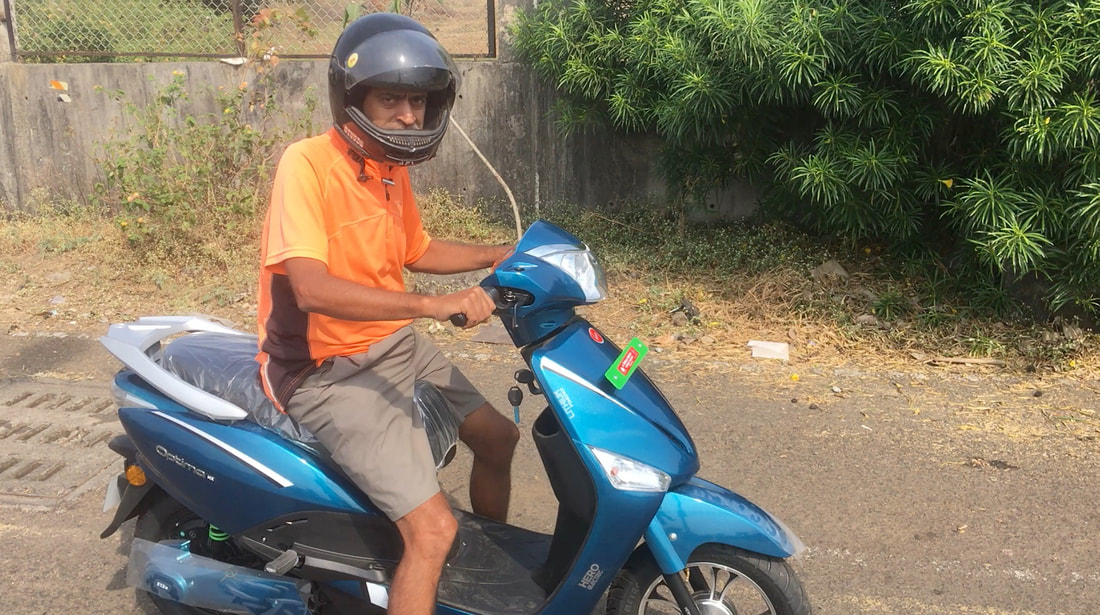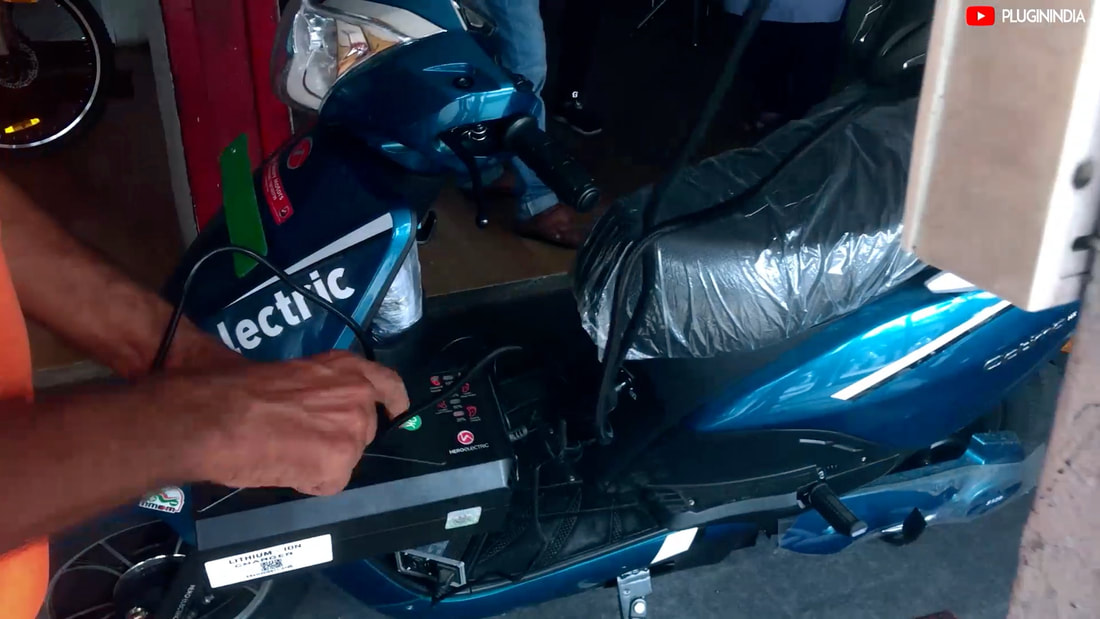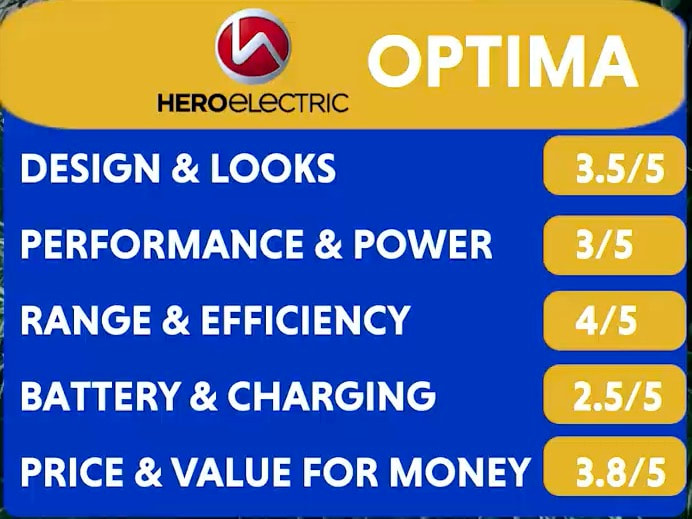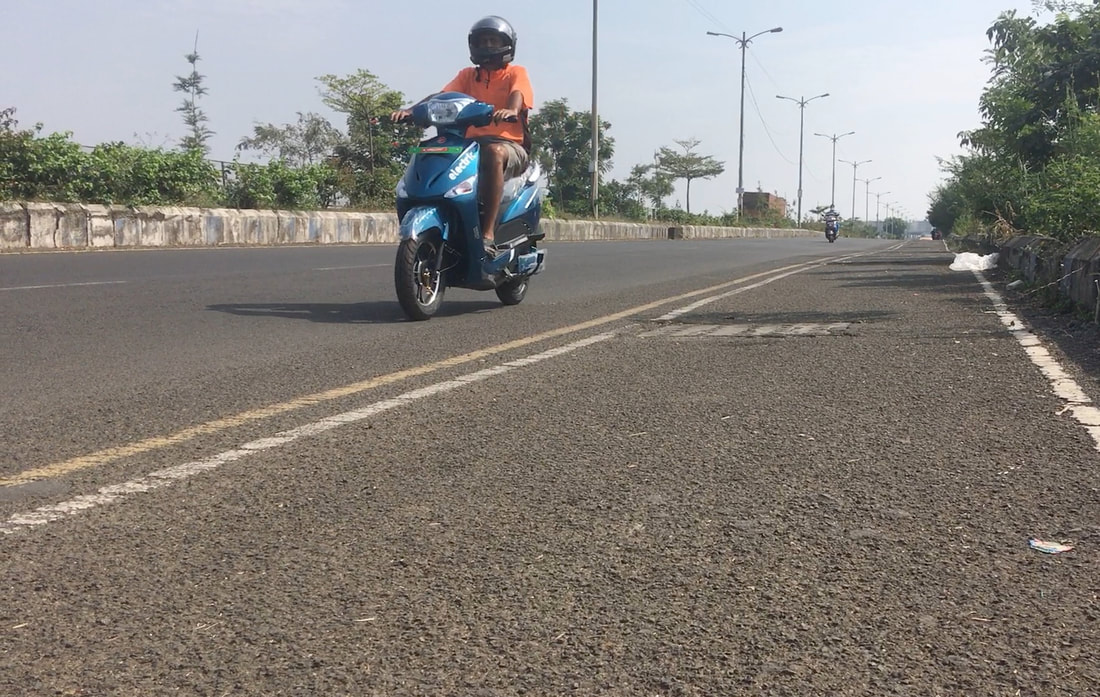By Atul Gopal
The PluginIndia team got the Hero Electric Optima electric scooter from the eGalaxy Motors, dealer in Pune for few days. The Hero Electric team have improved the Optima compared to the versions released during the previous decade. There is also a unique dual battery system for 100+ km range. In this article, we showcase our findings after testing the Hero Electric Optima electric scooter.
The PluginIndia team got the Hero Electric Optima electric scooter from the eGalaxy Motors, dealer in Pune for few days. The Hero Electric team have improved the Optima compared to the versions released during the previous decade. There is also a unique dual battery system for 100+ km range. In this article, we showcase our findings after testing the Hero Electric Optima electric scooter.
Video - Test Report : 2021 Hero Electric Optima Electric Scooter
We picked up the vehicle from eGalaxy in the evening. First impression: Hero is improving quite a bit over the years. The plastic panels are better finished. The color palette is wider. The switch quality has improved significantly. The pillion rider’s leg rests fold in and out without trouble. The Optima is one of the quietest gaadis that I have tested so far. Hero Electric’s products have been getting quieter over time. The free wheeling was good - so bearings quality has been upgraded. And what put a smile on the face was the prominent Electric badging on the front.
The vehicle has been designed for range - it promises 100 km+ - and having done about 60 km, am sure that it will deliver on that. The motor torque seems to be limited when you start, and which helps reduce peak current - again adding to the range. The top speed is just 42 kmph, which is not a significant increase over many low speed models in the market, which unofficially match the top speed. Though I do wish that Hero could shave off a second in the 0-40 kmph time. But possibly the top speed has also been designed taking into account the range maximisation optimisation. We know that as speed increases, range decreases. One more kaizen on the speed front is that there is no selector switch for modes, like we have in older Hero models. You are on Eco mode all the time.
Another thing that I liked is the suspension. The firm seat and firm suspension are suited for bad roads. My simple suspension test is to determine the max speed that the vehicle can have when it sails over a standard trapezoidal section speed breaker-cum-pedestrian-crossing. With the Optima, you can traverse these breakers easily at 40 kmph. The relatively less weight compared to ICE scooters must be helping. The seat width is generous, but the higher seating means that people who are 5 ft 4 inch or lower will struggle keeping their feet down at signals.
We were testing the Optima with the double battery pack. The battery packs are independent of each other - and that means that you can also leave one pack at home or office for charging, whilst you are out making deliveries. Another interesting kaizen is to provide two chargers with the vehicle - so that both packs can be charged in parallel and you can get a fully charged vehicle in 4 hours. There has been an upgrade in the BMS. A small sticker on the odometer informed me that if the voltage goes below 47 V, then you can expect a range of only 10 km. In order to remind the rider, the bike starts blinking the battery juice bar display once voltage dips below 47 V. I would recommend keeping the top battery as a spare one permanently. Removing the upper battery will also end up creating some valuable dicky space. We liked the fibreglass outer casing for the plastic battery box. Compared to the MS casing which is used in most of Hero’s other scooters, this will definitely save weight. To save further weight we would have been happier if the battery cells were packaged in a plastic case instead of the metal one being used currently. In the automotive industry, every gram matters, for extending the range.
The vehicle has been designed for range - it promises 100 km+ - and having done about 60 km, am sure that it will deliver on that. The motor torque seems to be limited when you start, and which helps reduce peak current - again adding to the range. The top speed is just 42 kmph, which is not a significant increase over many low speed models in the market, which unofficially match the top speed. Though I do wish that Hero could shave off a second in the 0-40 kmph time. But possibly the top speed has also been designed taking into account the range maximisation optimisation. We know that as speed increases, range decreases. One more kaizen on the speed front is that there is no selector switch for modes, like we have in older Hero models. You are on Eco mode all the time.
Another thing that I liked is the suspension. The firm seat and firm suspension are suited for bad roads. My simple suspension test is to determine the max speed that the vehicle can have when it sails over a standard trapezoidal section speed breaker-cum-pedestrian-crossing. With the Optima, you can traverse these breakers easily at 40 kmph. The relatively less weight compared to ICE scooters must be helping. The seat width is generous, but the higher seating means that people who are 5 ft 4 inch or lower will struggle keeping their feet down at signals.
We were testing the Optima with the double battery pack. The battery packs are independent of each other - and that means that you can also leave one pack at home or office for charging, whilst you are out making deliveries. Another interesting kaizen is to provide two chargers with the vehicle - so that both packs can be charged in parallel and you can get a fully charged vehicle in 4 hours. There has been an upgrade in the BMS. A small sticker on the odometer informed me that if the voltage goes below 47 V, then you can expect a range of only 10 km. In order to remind the rider, the bike starts blinking the battery juice bar display once voltage dips below 47 V. I would recommend keeping the top battery as a spare one permanently. Removing the upper battery will also end up creating some valuable dicky space. We liked the fibreglass outer casing for the plastic battery box. Compared to the MS casing which is used in most of Hero’s other scooters, this will definitely save weight. To save further weight we would have been happier if the battery cells were packaged in a plastic case instead of the metal one being used currently. In the automotive industry, every gram matters, for extending the range.
Another good news on the battery front is that Hero has started making its own battery packs in Ludhiana. We hope that this leads to an improvement in battery life. The fine print on the battery warranty has us worried. If the Ah rating of a 30 Ah battery is down to 25 Ah in 6 months, then the company talks of replacing this battery only with a 25 Ah battery and not 30 Ah, This shows a lack of confidence in the battery tech. Hero is a recent convert to LFP - and we hope that as their experience with this battery chemistry increases, they will change the battery warranty terms.
There are two non standard 3 pin round sockets used. Avoiding the standard Chigori connectors looks like a cost cutting measure to me. There is also a standard 3 pin socket - which I am not too sure of. The BMS has still not seen upgrades - still voltage based. One small sticker on the odometer now tells you that if voltage drops to 47 V, then you have only 10 km of battery left. Did not test that function - but there are voltage fluctuations when you drive - so figuring out which voltage to use as a reference can be a problem. The interior fits don’t seem to match the exterior ones. We tried taking the battery out and putting it in. The weight of the battery, at 11 kg, is ideal for swapping. (My battery expert friend, Abhay Patwardhan, finds the weight to be on the lesser side for LFP chemistry. He feels that the company may be using NMC chemistry for this double battery model.) The compartments though are flimsy. The whole purpose of having double batteries is that folks will take out the batteries and put them in. So if taking it in and out is an ordeal, then you lose the raison d'etre.
The good news is that there is regenerative braking. The not so good news is that there is not too much of it. There is a battery voltage indicator on the Odometer. And when you brake, for the first 1 to 2 seconds the voltage crosses 52 V, which means that the battery is being juiced up by the motor, which is now working as a generator. But after that, the mechanical brakes kick in. Front and rear are both drum brakes, so not too great. Would have been happier with a more aggressive regen - would have served the optimisation of the Optima’s range.
Another thing that worried me is the high center of gravity. The seat is located higher than the Activa - so the rider sits taller. Another issue is that the second battery sits taller. So the vehicle could have stability issues. The batteries do not fit snugly into their compartments, so the pack can move as the vehicle goes over bumps. These moving packs and shifting weights lead to rider anxiety. Maybe the company can try putting in some packing material and see if this reduces the problems. There is a chance that this problem was only with the vehicle we received for testing. But if it is generic to all Optima's, then this can be a deterrent to sales.
All in all the 2021 Optima definitely is an improvement compared to previous versions. The range of 100 km is the biggest plus point. The dual battery system is awkward to remove and charge.
The quality of the plastics housing the battery packs needs to be improved. We liked the handy switch in the boot to 'switch' battery packs.
There are two non standard 3 pin round sockets used. Avoiding the standard Chigori connectors looks like a cost cutting measure to me. There is also a standard 3 pin socket - which I am not too sure of. The BMS has still not seen upgrades - still voltage based. One small sticker on the odometer now tells you that if voltage drops to 47 V, then you have only 10 km of battery left. Did not test that function - but there are voltage fluctuations when you drive - so figuring out which voltage to use as a reference can be a problem. The interior fits don’t seem to match the exterior ones. We tried taking the battery out and putting it in. The weight of the battery, at 11 kg, is ideal for swapping. (My battery expert friend, Abhay Patwardhan, finds the weight to be on the lesser side for LFP chemistry. He feels that the company may be using NMC chemistry for this double battery model.) The compartments though are flimsy. The whole purpose of having double batteries is that folks will take out the batteries and put them in. So if taking it in and out is an ordeal, then you lose the raison d'etre.
The good news is that there is regenerative braking. The not so good news is that there is not too much of it. There is a battery voltage indicator on the Odometer. And when you brake, for the first 1 to 2 seconds the voltage crosses 52 V, which means that the battery is being juiced up by the motor, which is now working as a generator. But after that, the mechanical brakes kick in. Front and rear are both drum brakes, so not too great. Would have been happier with a more aggressive regen - would have served the optimisation of the Optima’s range.
Another thing that worried me is the high center of gravity. The seat is located higher than the Activa - so the rider sits taller. Another issue is that the second battery sits taller. So the vehicle could have stability issues. The batteries do not fit snugly into their compartments, so the pack can move as the vehicle goes over bumps. These moving packs and shifting weights lead to rider anxiety. Maybe the company can try putting in some packing material and see if this reduces the problems. There is a chance that this problem was only with the vehicle we received for testing. But if it is generic to all Optima's, then this can be a deterrent to sales.
All in all the 2021 Optima definitely is an improvement compared to previous versions. The range of 100 km is the biggest plus point. The dual battery system is awkward to remove and charge.
The quality of the plastics housing the battery packs needs to be improved. We liked the handy switch in the boot to 'switch' battery packs.




